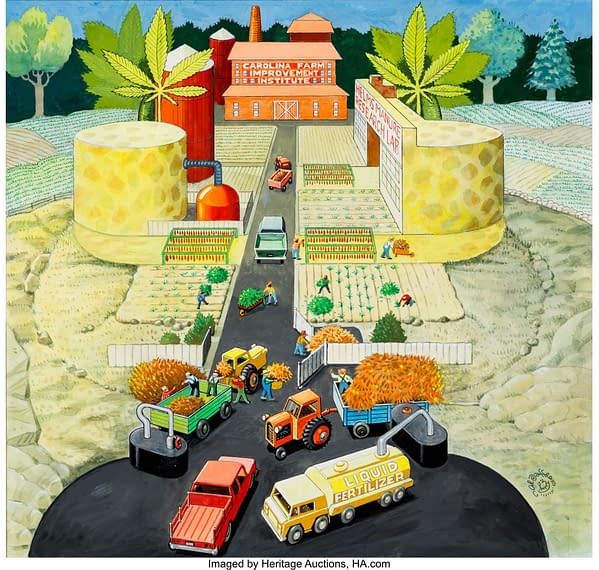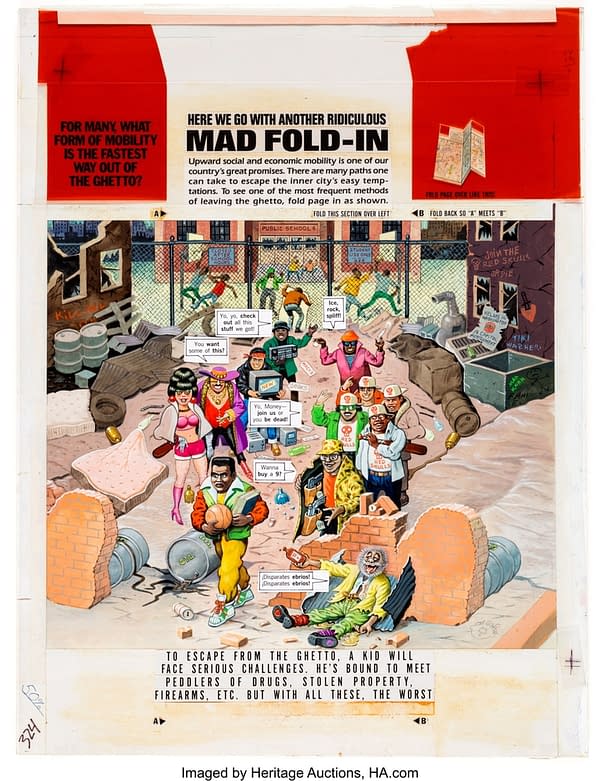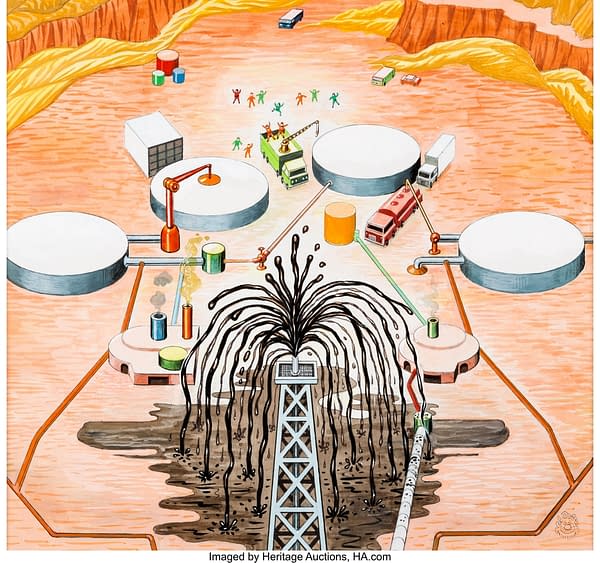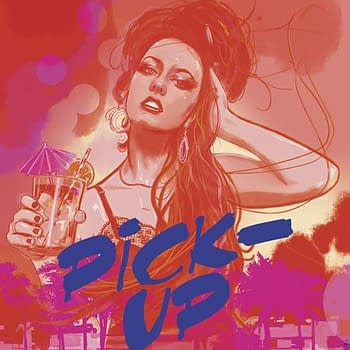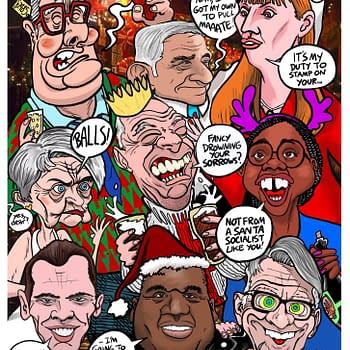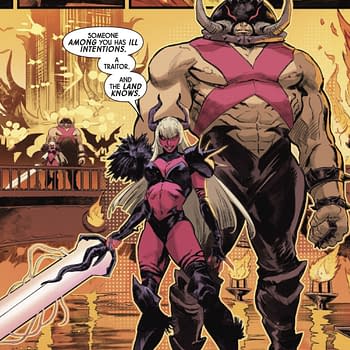Posted in: Comics, Comics, Heritage Sponsored, Sponsored | Tagged: Al Jaffee, auction, fold-in, heritage auction, Mad Magazine, sponsored
Three Al Jaffee MAD Magazine Fold-In Original Art Pages At Auction
Al Jaffee just celebrated his hundredth birthday. Born in 1921, he is best known for his work in the MAD Magazine, specifically his trademark feature, the MAD Fold-In.
Al Jaffee contributed to the magazine for 65 years, the longest run by a comic book artist on any periodical, ever. And working in comics from 1942 until 2020, Jaffee holds the Guinness World Record for having the longest-ever career as a comic artist. Between April 1964 and April 2013, only one issue of Mad was published without containing new material by Jaffee.
And as part of this weekend's Heritage Auction Online Catalog: Sunday & Monday Comics, Animation & Art lots, there are three original Al Jaffee art listings for the MAD Fold-Ins, as well as a page of his gag cartoons.
Al Jaffee MAD Inside Back Cover Illustration "MAD Fold-In" Original Art (EC Publ., c. 1990s). Jaffee's folding puzzle poses a mystery as to what the future of corporate agriculture might bring. Unusual to find a "Fold-In" painting without accompanying text, inasmuch as Jaffee customarily applied the typeset areas himself, as part of the finished artwork. Issue specifics are undocumented. Gouache on illustration board, measuring 17" x 16," expertly matted to 22.5" x 24". Signed at lower right. Excellent condition.
Al Jaffee MAD #324 Complete "MAD Fold-In" Original Art (EC Publ., 1994). An astonishing wealth of detail in Jaffee's folding puzzle, which asks: "For Many, What Form of Mobility Is the Fastest Way out of the Ghetto?" — referring on the surface to dope trafficking and gang violence. No fair giving away the hidden answer/punchline. Jaffee, of course, had no way of seeing his own final folded-in solution until a proof could be pulled or the page could be published, inasmuch as the heavy-duty illustration board is un-foldable. Snappy satire, here, from one of the magazine's longest-running features. Gouache with overlays, measuring 17" x 21.5". Slight toning, acetate layer taped at top, text paste-ups, tape along sides, far-corner dings. Excellent condition.
Al Jaffee MAD Inside Back Cover Illustration "MAD Fold-In" Original Art (EC Publ., c. 1990s). An oil derrick brings in a gusher, and the crew seems to be celebrating the strike — or maybe not, given the benevolent deceptiveness of Jaffee's inspired "Fold-In" feature, a staple of MAD since the 1960s. (The trick was to fold the published page inward upon itself, revealing hidden images.) It is unusual to find a "Fold-In" painting without accompanying text, inasmuch as Jaffee customarily applied the typeset areas himself, as part of the finished artwork. This one contains a tracing-paper overlay, showing where dialogue balloons should be placed. Issue specifics are undocumented. Gouache on illustration board, measuring approximately 16" x 16", expertly matted out to 22.5" x 27". Signed at lower right. Excellent condition.
Al Jaffee MAD Inventory Gags Complete "Disaster Can Befall You" Stories Original Art Group of 3 (EC Publ., 1990s). Jaffee imagines three desperate characters, each taking extreme measures to eliminate imagined threats — only to find themselves inviting destruction in unexpected ways, after all. Severe gallows humor, impeccably timed for maximum impact. Marked as "inventory" along with the MAD copyright notices (reverse), the panel-layout drawings appear to have gone unpublished. Ink over graphite on Bristol board, with occasional retouching/redrawing. Uniform image area, 16" x 9". Excellent condition.
The MAD Fold-In is one of the most well-known aspects of the magazine. The feature was conceived in response to centerfolds in popular magazines, particularly Playboy. Jaffee stated "Playboy had a foldout of a beautiful woman in each issue, and Life Magazine had these large, striking foldouts in which they'd show how the earth began or the solar system or something on that order — some massive panorama. Many magazines were hopping on the bandwagon, offering similar full-color spreads to their readers. I noticed this and thought, what's a good satirical comment on the trend? Then I figured, why not reverse it? If other magazines are doing these big, full-color foldouts, well, cheap old Mad should go completely the opposite way and do an ultra-modest black-and-white Fold-In!"
A Mad Fold-In consists of a single drawing, with a paragraph of text underneath, and a panel across the top with a question. Each Fold-In also features instructions on how to manipulate the Fold-In, as well as a picture illustrating the procedure. Under the instructions are two arrows labeled "A" and "B". When the paper is folded so that points "A" and "B" are touching, the remaining unobscured text underneath the picture becomes the answer to the question, and the picture itself changes into a fresh image reflecting the new text, as the middle 50% of the drawing vanishes.
For example, a 1969 Fold-In asking, "What is the one thing protest marches have greatly improved?" depicted a stream of placard-carrying marchers, but folded into the image of the underside of a worn-out sole and the answer, "SHOE SALES." A drawing of a fearsome panther stalking a variety of jungle animals accompanying the question "What predatory creature most threatens the survival of endangered species?" contracted to the image of a lavishly swaddled woman and the solution "FUR LOVERS." (In the larger drawing, the two halves of her fur coat had been the foliage of trees.) Following the 1991 Tailhook scandal, a Navy war room became a female officer being sexually molested by a gauntlet of her comrades.
Mad publisher Bill Gaines joked that he was a fan of the Fold-In because he knew that serious collectors valued pristine, unfolded copies, and would therefore be inspired to purchase two copies of each issue: one to fold and another to preserve intact.



